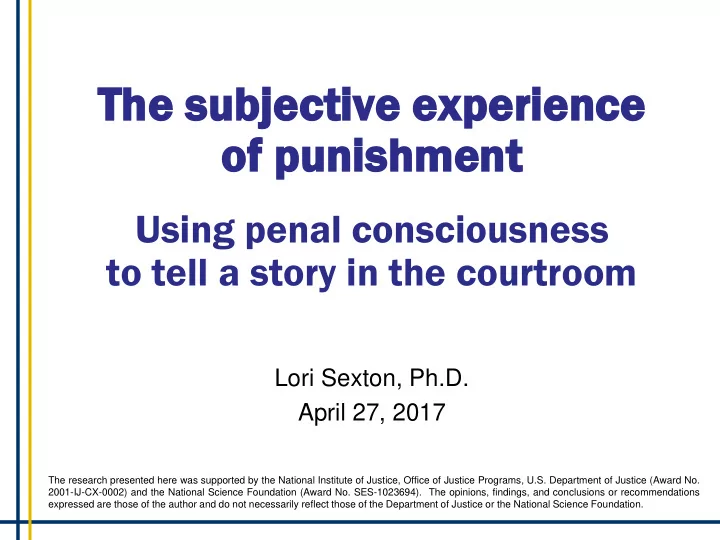

The su subj bjective e experi rience of pu of punishment nishment Using penal consciousness to tell a story in the courtroom Lori Sexton, Ph.D. April 27, 2017 The research presented here was supported by the National Institute of Justice, Office of Justice Programs, U.S. Department of Justice (Award No. 2001-IJ-CX-0002) and the National Science Foundation (Award No. SES-1023694). The opinions, findings, and conclusions or recommendations expressed are those of the author and do not necessarily reflect those of the Department of Justice or the National Science Foundation.
What is penal consciousness… and why does it matter? • Penal consciousness: Prisoners’ subjective experience of punishment • Concerned with what prisoners consider to be punishment while incarcerated • Rather than what is designed or intended to be punishment
Overview of presentation • Brief explanation of penal consciousness theoretical framework • How penal consciousness can help tell a story in the courtroom • Application of framework to Sheppard case • Implications for post-release prospects and compatibility with traditional risk assessment
Development of penal consciousness framework • Semi-structured interviews 80 Ohio state prisoners • 61% were lifers • 49% were serving time for murder/manslaughter • Inductive analysis • 88 hours of audio recording • 2,500 pages of transcription • Goal: To understand how prisoners make sense of their punishment
Content of punishment • Concrete punishment: Unmet daily needs • Medical neglect or mistreatment • Breakdown of amenities • Expense of daily necessities • Inadequate or unhealthy food • Symbolic punishment: Major losses • Loss of freedom • Loss of autonomy • Loss of self • Loss of personhood • Loss of family
Severity of punishment • Severity: Intensity or magnitude of punishment as experienced by the prisoner More severe Less severe - + Concrete Symbolic punishment punishment Medical neglect or mistreatment Loss of freedom Breakdown of amenities Loss of autonomy Expense of daily necessities Loss of family Inadequate or unhealthy food
Beyond severity: Salience and the role of expectation • Salience: Prominence of punishment in the prisoner’s life • Determined by the alignment of expectation and experience of punishment • Expectations of punishment based on: • What punishment will be • What punishment should or ought to be
Salience, expectation, and the punishment gap Expectation Experience Salience More severe Less severe - + Punishment gap
Salience, severity and narratives of penal consciousness
Punishment as part of life • Lowest in overall harshness • Time spent in prison is seen as one of many phases of the lifecourse • Much like childhood, adolescence, college, or marriage • This doesn’t imply that prison is seen as normative or necessary • Or that time spent in prison is short
Punishment as death • Highest in overall harshness • Time spent in prison isn’t life at all—it is experienced as death • Varied temporality of death • Single, quick (though not painless) death upon entering prison • Single, ongoing death that lasts for the duration of their incarceration • “ A thousand small deaths ” experienced on a daily basis • Very common among lifers
Implications for reentry • These narratives give us a sense of how prisoners will adjust to life outside prison • The story that penal consciousness tells can help judges understand how prisoners’ experienced their punishment • And more importantly, what this individual experience means for reentry prospects
Sheppard case: Materials and analysis • 2 in-person interviews • Approx. 3 hours each • 1 written letter • Extensive background and case documentation provided by CLS Mitigation • Life history • Incarceration history and timeline • Prison records (disciplinary, programming, work, treatment, mental health) • Line-by-line analysis to determine penal consciousness
Sheppard case: Severity of punishment More severe Less severe - + Maximum security prison Surrounded by violence Loss of family Time in segregation
Sheppard case: Salience of punishment Expectation Experience More severe Salience Less severe - + Punishment gap Juvenile at time of offense Not charged with murder or manslaughter Mandatory LWOP Frequent prison moves (including seg)
Sheppard’s Penal Consciousness Bryan Sheppard
Sheppard’s Penal Consciousness
Implications for release • Consider in context of re-entry risk and protective factors • Documented barriers to prisoner reentry: • Stigma of a felony conviction • Financial hardship • Availability of drugs and alcohol • Criminogenic surroundings
Protective factors • Positive prison record TIME IN PRISON PRISON RECORD 21 years 9 disciplinary incidents = x 7,665 days 5 minutes per incident = = 183,930 hours 45 minutes of misbehavior = 11,037,600 minutes Approx. 2 minutes of misbehavior per year
Protective factors • Positive prison record • Education • Drug treatment / maintained sobriety • Mental health treatment • Emotional and cognitive skills developed • Support system • Age • Future orientation
Punishment is not the whole story— but it is an important piece
Contact Lori Sexton, Ph.D. Assistant Professor Criminal Justice and Criminology University of Missouri-Kansas City sextonl@umkc.edu
Recommend
More recommend